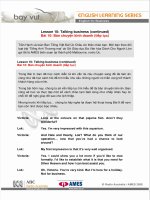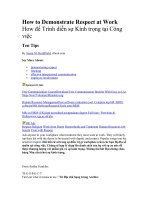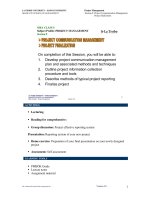Talking Business: Making Communication Work pdf
Bạn đang xem bản rút gọn của tài liệu. Xem và tải ngay bản đầy đủ của tài liệu tại đây (1.03 MB, 241 trang )
Talking Business:
Making Communication Work
This Page Intentionally Left Blank
Talking Business:
Making Communication Work
David Clutterbuck and Sheila Hirst
Researched by Stephanie Cage
OXFORD AMSTERDAM BOSTON LONDON NEW YORK PARIS
SAN DIEGO SAN FRANCISCO SINGAPORE SYDNEY TOKYO
Butterworth-Heinemann
An imprint of Elsevier Science
Linacre House, Jordan Hill, Oxford OX2 8DP
200 Wheeler Road, Burlington, MA 01803
First published 2002
Copyright © 2002, The Item Group Ltd. All rights reserved
The rights of David Clutterbuck and Sheila Hirst to be identified as the authors
of this work has been asserted in accordance with the Copyright, Designs and
Patents Act 1988
No part of this publication may be reproduced in any material form (including
photocopying or storing in any medium by electronic means and whether
or not transiently or incidentally to some other use of this publication) without
the written permission of the copyright holder except in accordance with the
provisions of the Copyright, Designs and Patents Act 1988 or under the terms of
a licence issued by the Copyright Licensing Agency Ltd, 90 Tottenham Court Road,
London, England W1T 4LP. Applications for the copyright holder’s written
permission to reproduce any part of this publication should be addressed
to the publisher
British Library Cataloguing in Publication Data
A catalogue record for this book is available from the British Library
Library of Congress Cataloguing in Publication Data
A catalogue record for this book is available from the Library of Congress
ISBN 0 7506 5499 6
For information on all Butterworth-Heinemann publications visit our
website at: www.bh.com
Composition by Genesis Typesetting, Rochester, Kent
Printed and bound in Great Britain
v
Contents
List of figures vii
List of tables ix
Acknowledgements x
Preface xi
List of abbreviations xiii
Introduction xv
1 Business performance and communication excellence 1
2 Some core tools and concepts in employee
communication 18
3 The internal community of communication 33
4 The employee as stakeholder – a crisis of identity 53
5 Vision and values: mirage and sentiment? 79
6 Communication during radical change 90
7 Communicating the brand: the pivotal role of
employees 120
8 M&A (mayhem and anarchy?) 140
9 Building communication capability through
interpersonal competence 167
10 Building communication capability through technology 191
11 Consolidating communication capability 199
Index 207
This Page Intentionally Left Blank
vii
Figures
1.1 The communication profit chain
1.2 What we found
1.3 The evidence: how clarity of purpose relates to business
success
1.4 The evidence: how effective interfaces relate to business
success
1.5 The evidence: how leadership communication relates to
business success
1.6 Four pillars of communication excellence
3.1 Communication as the key interface between
organizational activities
3.2 What business is the staff function in?
4.1 Prioritizing stakeholder demands
4.2 Remote relational communication: the black hole?
6.1 When communicators get involved in change
6.2 A model of organizational change
6.3 How individuals change
6.4 Types of change resistance and how best to overcome
them
6.5 The core elements of change communication
6.6 The change funnel
7.1 Four expressions of brand
8.1 The stages of emotional response to change
8.2 Uncertainty versus impact
8.3 Core elements of communication management in M&A
8.4 Structure of M&A communication
8.5 Communication style versus terms of respect
8.6 Perception of outcomes versus alignment of values and
beliefs
9.1 Five levels of communication competence
9.2 The communication cycle
11.1 Tomorrow’s integrated communication structure
This Page Intentionally Left Blank
ix
Tables
0.1 Communication style versus impact
0.2 The cascade of communication
0.3 Involvement of the internal communication function
1.1 Top management communication behaviour
1.2 Clarity of purpose versus knowledge sharing
2.1 A sample receptivity map
2.2 Checklist used for benchmarking
3.1 Functions versus activities matrix
3.2 Functional strategy versus communication purpose
3.3 Positive and negative communication climate
4.1 Goals of CRM, IRM and ERM
7.1 Four expressions of brand
8.1 Who is impacted by acquisition?
8.2 The Worry Index
8.3 A lexicon of acquisition double-speak
8.4 Timing of M&A communication with employees
8.5 Learning about each other – some key questions
9.1 Communication competence for different types of team
9.2 The manager as communicator: twentieth-century versus
twenty-first-century norms
9.3 A situational matrix of communication
11.1 Where does internal communication belong?
x
Acknowledgements
We would like to thank everyone at item who contributed to this
book, especially Clive, Alison, Karen, Domna and Cami for their
valuable input, Ian and Anthony for their assistance with the case
studies, Debs and John for making the visuals happen, and Matt
for helping put it all together.
We would also like to thank Susan Walker at MORI for
providing us with some useful facts and figures.
Our thanks go to all at Butterworth-Heinemann for making
this book possible. Lastly, but perhaps most importantly, thanks
to all the organizations featured in the book for their time and
generosity in sharing their experiences.
xi
Preface
Why do we need another book about communication? It does not
take much of a search through the many publications on internal
(employee) communication, to realize that almost everything
available is either focused on telling people how to make better
presentations/influence people, or is heavily biased towards the
academic.
The problem with the former is that printed advice is one of the
least effective means of bringing about personal change. More-
over, for the communication professional or the manager, whose
need concerns achieving effective organizational communication,
there is little in these publications to make their job easier: a job
increasingly dominated by the need to support and encourage
major change within their organization.
The problem with academic texts is that they tend to be very
narrowly focused on a specific issue, which may or not be
relevant to practical application. The academic search for truth is
neither interested in, nor intended to address, what is keeping
managers awake at night.
There are surprisingly few resources of comprehensive guid-
ance for those entrusted with making communication work in
organizations. (We use throughout this book the term communica-
tion for the process and skill of communicating; communications
for the technologies that enable communicating.) At the level of
implementation, The Gower Handbook of Employee Communication,
which we created in 1997, remains a primary source of reference,
particularly in the UK and Europe. Now, in this volume, we aim
to fill some of the gap in relating communication strategy both to
the business priorities and to the implementation processes.
This book is not intended to give detailed step-by-step
instructions on every piece of successful practice. It is intended to
provide a clear route map for those struggling with the challenge
of making their organization’s employee communications equal
to the task.
xii
Preface
In short, we offer you in Talking Business a whirlwind tour
through today’s and tomorrow’s world of internal communica-
tion. We guarantee that you will find some new ideas, some new
ways of tackling employee communication issues, some new
arguments for achieving communication objectives. Please sit
back comfortably and enjoy the ride.
David Clutterbuck and Sheila Hirst
May 2002
xiii
Abbreviations
AI artificial intelligence
ASPIC Association for Strategy and Planning in Internal
Communication
CEO chief executive officer
CIPD Chartered Institute of Personnel and Development
CIR critical incident reporting
CRM customer relationship management
DfEE Department for Education and Employment
DTI Department of Trade and Industry
ERM employee relationship management
GICS Government Information and Communication
Services
HR Human Resources
IABC International Association of Business Communicators
IC internal communication
IRM investor relationship management
IT information technology
M&A mergers and acquisitions
PR public relations
PRS personal reflective space
SPEX Shell Philippines Exploration
This Page Intentionally Left Blank
xv
Introduction
What is the need for internal communication?
One of the depressing features of MORI surveys of internal
communication is how little impact much of the activity in this
area appears to have made. Over a period of thirty years,
employees’ average satisfaction with communications from their
organization has remained steady at around 50 per cent.
Yet internal communication activity has blossomed in recent
years. According to item research, the number of people
employed inside companies in internal communication roles has
risen steadily in the past decade, with under a fifth of
communication departments boasting five or more full time
professionals in 1996, compared with almost a third in 2001. The
scope of their activities has also increased, with the majority of
communicators saying they feel their role is more strategic, more
clearly defined and more valued than five years ago. The
function now attracts some of the brightest of the rising stars in
organizations.
In their responses to questions raised in the Business Intelli-
gence reports of 1996 and 2001, the heads of internal communica-
tion functions admit, too, that those areas of activity, which they
recognize as having greatest value for the business are all too
often those that they deliver on least effectively. Roles which
communications professionals consider among the most impor-
tant but least successful are improving managers’ communica-
tion skills, enhancing employees’ motivation, communicating the
company’s mission, vision and values, enhancing the credibility
of the top team and encouraging feedback.
So what has gone wrong? Is it just that internal communica-
tion, like any other business discipline, is going through a natural
maturing process, under which enthusiasm gradually becomes
replaced by efficacy? Or are there serious flaws in the concept
and practice of employee communication?
xvi
Introduction
The answer, we believe, lies somewhere in between the two.
Part of the problem is that people’s expectations have increased
alongside organizations’ capacity to deliver. A rough estimate is
that the volume of information readily available to people in the
developed world – both at work and at home – has doubled
every five years over the past three decades. (The actual volume
of information generated has almost certainly increased even
faster, but the capacity to access it easily has lagged behind.)
The explosion of web sites and databases is only part of the
picture. The number of print-based periodicals on retailers’
shelves has also expanded dramatically. The UK Periodical
Publisher’s Association registers about 3000 titles, while the
European Federation of Magazine Publishers represents 36 000. In
2000, the US-based National Directory of Magazines listed about
17 800 publications (up from 14 000 in 1990). In a world where
information on all manner of topics – from medicine to macram´e,
politics to pornography – is on open access, it is hardly surprising
that people expect a similar level of disclosure at work.
However, communication is not just about making information
available. That is the easy bit and the main contribution of
e-technology has been to increase the emphasis organizations
place on one-way communication. To feel that they are in genuine
communication people require an interaction. No matter how
personalized a one-way communication is, it cannot provide the
intellectual and emotional engagement that comes from discus-
sion and, at a higher level of interaction, from dialogue. When
people complain that they do not feel the organization or their
managers communicate well with them, they typically are
concerned less about raw information than the quality of the
interactions that give them context and a sense of involvement.
Yet, wherever we look in large organizations, we see that the bulk
of communication spend is on media, which are predominantly
one-way in their application and impact.
In terms of stimulating genuine, lasting change, we can
categorize communication as shown in Table 1.
Common myths about communication in organizations
Most people in organizations still operate under a series of
misconceptions about the nature of communication. This ham-
pers them using communication as an effective driver of strategic
change. This book aims, in part, to address the misconceptions
and to suggest practical alternative concepts and approaches – in
some cases backed up by examples from the experience of
companies which have attempted to take a more strategic view
xvii
Introduction
of communication. (Please note that we use ‘strategic’ here in a
very specific manner – to mean the close alignment of the
communication process with clear business goals and
priorities.)
Among these myths of organizational communication are:
᭹
Communication is something you do to people. Top management in
many companies perceive communication as a process of
getting messages across to the employees, so that they know
what is expected of them and why. Effective communication,
however, is a process of dialogue, which we can define as the
development of mutual understanding. Cases such as BP’s diver-
sity programme illustrate how much more powerful dialogue
can be than instruction or discussion.
᭹
Most managers are reasonably good communicators, otherwise they
would not be in the role. This is like saying that being a good
parent comes naturally. To a few, fortunate people, it does.
Most of us are passable at parenting and at communicating –
we do the best we can – and some are just plain dreadful. The
reality in most organizations is that most managers spend a
high proportion of their time avoiding communicating. When it
is done well it demands substantial mental effort, the allocation
of reflective time and the courage to face up to challenge and/
or discomfort.
᭹
You are either a good communicator or you are not. Again, our
research shows that this view (paradoxically often held
simultaneously with the previous) is simplistic and largely
Table 1 Communication style versus impact
Style Type of media Type and scale of impact
Informing Memoranda, employee
periodicals (print and e-zine),
most intranet sites
Raising awareness
Change index* = 1
Discussion Briefing groups, chat rooms Raising understanding
Change index* = 3
Dialogue Facilitated meetings,
coaching and mentoring
sessions, team learning
Building commitment and
stimulating behaviour change
Change index* = 8–10
Note: *item’s change index is a measure of the potential to bring about major positive
changes for the organization.
xviii
Introduction
inaccurate. Yes, there are people with specific communication
defects – for example, those who suffer from forms of Asperger
Syndrome or Semantic Pragmatic Disorder – but for most
people, communication competence is a situational skill. You
may have an employee, who appears to be very poor at
listening. Start talking about his or her next salary increase, or
favourite football club, and that employee is likely to transform
into a remarkably attentive listener.
᭹
Communication is the job of the communication function. This is
akin to saying that Human Resources (HR) is the responsibility
of the HR function. In both cases, the function is no more than
being a co-ordinator and enabler – the provider of support
systems and advice to managers on how to contribute. The
more a company tries to shift the responsibility for commu-
nication onto the communication professionals, the less com-
munication actually takes place.
᭹
Awards and prizes by external bodies are a demonstration and
recognition of communication excellence. Wrong! Our researches
show that there is little or no correlation between these two
factors. On the contrary: professionally produced, prize-
winning employee periodicals or web sites are very frequently
associated with poor business performance (along with the
flagpole, fishpond and corporate jet!). Only when media
contribute significantly to the achievement of business goals
and priorities do they add value.
᭹
Communication can (or should) be controlled. The reality is that
probably less than 10 per cent of communication in an
organization is formal. The rest happens through informal
exchanges at coffee machines, by e-mail and through more
subtle media, such as behaviour and what is not said. Of that 10
per cent, the vast majority comes through a mixture of staff and
line, with the communication function generating no more
than 2 per cent. Human Resources, operations, legal, informa-
tion technology (IT) and other functions are constantly
engaged in communicating (or some semblance of it). The
communication function that attempts to control communica-
tion simply generates new forms of informal channel. A more
effective role for the function is to enable communication and
help raise its quality in terms of relevance, reliability and
clarity.
᭹
There is/should be a clear chain of communication, alongside the
chain of command. Given the increasingly rapid spread of matrix
structures in organizations – often with more than two
dimensions – it is very difficult to see how this could apply in
such an environment. Even in a more traditional structure,
however, the flow of communication is broadly chaotic and
Managers
Staff
Line
Employees
Suppliers
Customers
Leaders
Line
Staff
Staff
Line
xix
Introduction
this phenomenon has been reinforced by the ability of e-mail to
cut across departmental and hierarchical barriers. The diagram
illustrates the different links in the communication chain. Gaps
commonly appear in all or some of them depending on the
organization.
All these issues are addressed in greater depth in the chapters
of this book, which draws together theory, research, practical
experience and pragmatic advice.
Why do businesses need to communicate better?
From Peter Drucker to Tom Peters and current management
gurus, there have been two consistent strains – the importance of
leadership behaviour and the value of communication as the glue
that holds the organization together. Numerous studies of senior
management attitudes confirm the same picture – communica-
tion matters. One MORI survey of board directors and other
influential business people found that 76 per cent believed that
cultivating goodwill among existing employees is essential. In
fact, employees came second to only one other stakeholder group
– existing customers, at 80 per cent.
Where the evidence is sadly lacking is for the importance of the
internal communication function. In item’s research for the
International Association of Business Communicators (IABC)
study into the relationship between communication competence
and business success, we examined over a hundred research
reports, papers and articles and found at best partial support for
the view that the internal communication (IC) function did
anything demonstrably useful.
xx
Introduction
So why has the IC function grown so rapidly? Some of the key
factors include:
1 Desperation by top management to make strategy happen. In
flatter hierarchies, it becomes much more important for people
to understand what they are supposed to do and why. There
are fewer people to point them in the right direction – most
knowledge/service workers are to a greater or lesser extent on
their own.
2 The speed of change means that top management has to
sustain people’s interest and commitment, overcoming their
resistance to initiatives.
3 Increasing mergers and acquisition (M&A) activity creates new
anxieties, which must be managed if the new company is not to
be mired in recriminations.
4 Fear by top management about losing control of communica-
tion, as technology allows people access to almost anything
and encourages people to communicate directly rather than
through hierarchical silos. E-technology increases their sense of
anxiety, as more and more people feel besieged by information
rather than liberated by it.
5 Increasing attention to brand and corporate reputation means
that companies need consistency in what people say and do, at
all levels.
6 Retaining people is the big challenge for knowledge businesses
– being informed is one of the ways to help keep them.
7 Other functions within the business need help with their own
internal reputation. Most professionals do not see marketing as
part of their own role, and even if they have the skills, many
find it difficult to make time for it, so they have begun to turn
to IC for help.
All these pressures have helped raise top management’s expecta-
tion of IC from being a small-time provider of services (company
periodical, some speechwriting for the chief executive officer and
organizing the occasional event) to an advisory function, a little
like HR in that it helps them to avoid problems. There is now a
gradual evolution, to an internal consultancy, which enables the
business to use communication for competitive advantage –
that’s the challenge to IC for the next decade.
A bedrock theory of employee communication
Because everyone communicates (we now finally even appear to
know the specific gene sets that give humans this special
xxi
Introduction
capability), people tend to assume that they have a common
understanding of what communication is, what it is for and how
it works. Even communication professionals often take these
same assumptions for granted, although they should be at least
peripherally aware that those who come from, say, a marketing
background are likely to have different perceptions of commu-
nication from those with an Human Resources background. (This
simple sentence illustrates the point – why do we feel obliged to
capitalize HR, but not marketing?)
So before we get too deeply into the nitty-gritty of communica-
tion strategy, let us consider for a moment what we mean by
communication and by employee communication.
The nature of communication
Communication occurs whenever there is a meaningful inter-
change between two or more people. You might be tempted to
insert the words ‘of information’ in that terse definition, but there
are at least two good reasons not to. One is that a great deal of
communication occurs at the unconscious sensory level. This is
not strictly information, but data. Data only becomes information
when it is structured to elicit some form of meaning. The second
is that, in addition to the transfer of data and information,
communication may also transfer knowledge (information struc-
tured in a way that makes it useful for making choices or
decisions); skills (knowledge and information translated into
practical application or know-how); and wisdom (the ability to
extrapolate from data, information, knowledge and skills to
tackle new situations).
Key to effective communication, whether between individuals,
organizations or a combination of the two, is structure. The
Table 2 The cascade of communication
Data
Informing
Information
·
Knowledge
Discussion
Skills
·
Dialogue
Wisdom
·
xxii
Introduction
essence of language is a shared set of norms about meaning and
about the order in which elements of meaning are transmitted. In
general, linguistic psychologists such as Steven Pinker (author of
The Language Instinct, 1994) believe that most of these rules are
genetically imprinted. Structure reduces the mental effort in
analysing communication, because the rules largely predict the
meaning. Wordplays amuse, because they retain expected struc-
tures, while changing the expected meaning.
Although some purposes of communication (for example,
international conventions or treaties) may be best served by
encouraging multiple interpretations of the same text, in general,
greater clarity of meaning – where everyone has a similar
understanding of what is meant – is normally beneficial on all
sides. However, clarity is often low because:
᭹
people place different filters, based on culture, personality or
experience, on what they hear
᭹
people often speak before they have sorted out in their mind
what they want to say and what impact they want it to have (then
they are surprised by the other person’s reaction!)
᭹
people are reluctant to cause themselves or others pain or
embarrassment by pointing out directly things that they think
are wrong
᭹
people do not recognize their own or other people’s
stereotypes
᭹
people often lack the verbal dexterity to express ideas concisely
and accurately, or in language appropriate to the recipients
᭹
good communication requires an appropriate balance of
intellectual observation/analysis and emotional involvement.
When the balance is disturbed, in either direction, communica-
tion is disrupted
᭹
when there are too many ideas to be communicated at the same
time, either the speaker or the receiver (or both) is likely to
suffer from ‘channel overload’.
These seven causes of low clarity in communication apply
equally to individuals and to organizations. In both cases,
considerable improvements can be made by a planned approach
that helps the individual or organization to address each factor as
a development issue. Developing the competence of dialogue
requires changes in both behaviour and process.
For the moment, however, let us focus on the organizational
issues. Given that clarity is so important, one of the first tasks of
any internal communication department is to define what
internal communication is.
The values triangle
Customer
Company
perception
Employee
Respect
Worth Belief
xxiii
Introduction
The purpose of internal communication
This is the point where it is tempting to embark on a lengthy
discussion of the merits of different definitions. Our experience,
however, is that this does little to clarify, and may even make
meaning more obscure. So we unashamedly assert that:
The purpose of internal communication is to assist people in
an organization to work together and learn together in
pursuit of shared goals and/or the mutual creation of value.
Let us take the key elements of this one by one. The purpose is to
assist people because effective communication is a collaborative
process, which relies on their willingness to share information
and to listen to others. People need communication to work
together, i.e. to link their activities with those of others in the
organization, and with people outside the organization, such as
customers and suppliers. They also need to learn together to
adapt what they and the organization do to changes in their
environment.
Pursuing shared goals does not mean that everyone has to share
exactly the same goals. There has to be at least one broad,
differentiating goal that everyone signs up to – like staying in
business by building customer loyalty – but subgoals may be
different between working groups. People’s individual goals also
need to be recognized, accepted as valid, and accommodated to
a level which seems reasonable to them, the organization and
other stakeholders, inside or outside the organization.
The same is true of mutual creation of value. The concept is best
expressed in the diagram.
Basically, the more the organization and the people in it focus on
᭹
building value (in the sense of worth of shares for investors,
marketability for employees etc.)
᭹
demonstrating value (in the sense of showing that you respect
and appreciate each other’s efforts and contributions)
xxiv
Introduction
᭹
understanding values (in the sense of what people believe,
what is important to them),
the more likely the organization is to achieve the state of
continuous constructive dialogue, which should be the foundation
of innovation, teamwork and all those other enabling behaviours
that lead to sustainable competitive advantage.
In essence, communication is a contract between individuals,
the organization and each other. Communication only works
when people are willing to engage with others. The quality of
communication depends on whether the ‘contract’ is one of
listening, discussing or genuine dialogue.
Improving the quality of communication takes time and
sustained energy. It can be useful to think of the journey as one
towards communication maturity, which is in effect the ability of
individuals and the organization to engage in continuous dialogue that
leads to action. This concept is explored further in Chapter 6,
‘Communicating during radical change’.
The role of the internal communication function
Based on the definition of purpose for internal communication,
the IC function can be defined as to support and enable the
communication process within the organization.
We can further refine that bald statement to say that the role is
primarily:
To assist the organization and the people within it to enhance
communication capability and
To provide support, in the form of advice, measurement
processes and practical help in the design and delivery of
media.
This is a very broad remit, which covers almost any area of
activity within an organization. It is not surprising that many
companies place young high-flyers in the internal communica-
tion function, recognizing that they will have here an opportunity
to get to know the company very widely, develop an extensive
network of senior management contacts and insights into how
the systems really work.
Just how wide the remit is, is illustrated by the involvement of
the internal communication function.
The very breadth of activity is also a problem, however. Many
IC departments we have spoken to at Association for Strategy
and Planning in Internal Communication (ASPIC) events and in









